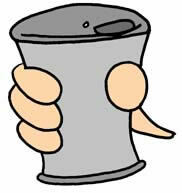Geometric solids are three-dimensional objects that occupy space. That's why they have volume. We can find solids of countless shapes, rectangular, circular, quadrangular, among others, but all will have volume and capacity. The most used volume units are: cubic meter (m³), cubic decimeter (dm³) and cubic centimeter (cm³). Among the most used capacity measures we have the liter (l) it's the milliliter (ml).
We can relate volume measurements to the capacity of a geometric solid. Look:
1 cubic meter (m³) corresponds to a capacity of 1000 liters.
1 cubic decimeter (dm³) corresponds to a capacity of 1 liter.
1 cubic centimeter (cm³) corresponds to a capacity of 1 milliliter (ml).
A can of soda contains 350 ml of liquid, so we can say that its volume is equal to 350 cm³.

A school's water tank has a volume of 10 m³, that is, its capacity is 10,000 liters of storage.

A carton of long-life milk is 1 cubic decimeter in volume, so we say its capacity is 1 liter.

It is important to remember that the 1 liter capacity measure corresponds to 1000 milliliters (ml).
by Mark Noah
Mathematical
Related video lesson:


